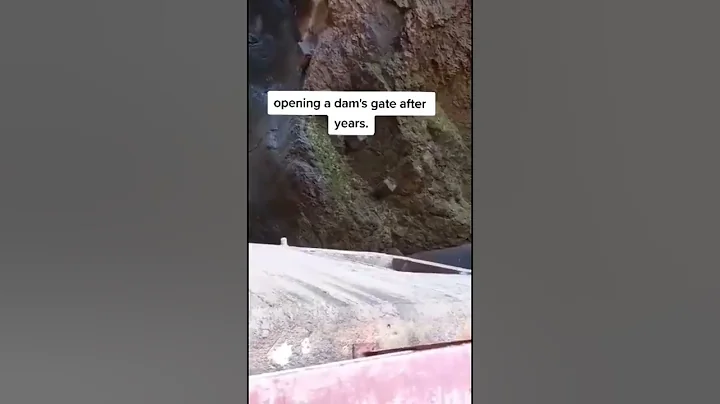reservoir is an important engineering measure to regulate the spatial and temporal distribution of water resources, optimize water resource allocation, and ensure the safety of river flood control. It is an important and irreplaceable infrastructure for economic and social development and ecological environment improvement. After the founding of the People's Republic of China, the dam building industry developed rapidly. As of the end of 2019, a total of 98,112 reservoirs of various types were built across the country (excluding Hong Kong, Macao, and Taiwan), with a total storage capacity of 898.3 billion m³, including 2,744 large reservoirs, 3,978 medium-sized reservoirs, and 93,390 small reservoirs.

The scale and dam type distribution of reservoir dams registered in the Ministry of Water Resources
▍Safety status of reservoir dams
Due to restrictions in economic and technical conditions, reservoir dams built in the 1950s to 1970s generally left many engineering safety hazards. At the same time, the dams built in the 1980s and 1990s have been in operation for more than 20 years. As their service life increases, some aging diseases gradually appear. Dangerous reservoirs pose an important threat to the lives and property safety of the people downstream and have become shortcomings and weak links in the national flood control safety system.
China has always attached great importance to the safety of reservoirs and dams and the removal and reinforcement of dangerous reservoirs. As early as after the "75·8" flood, 65 large reservoirs were risk-relieved and reinforced with the main purpose of improving flood control standards. In 1986 and 1992, the country identified the first batch of 43 and the second batch of 38 key dangerous reservoirs that needed to be eliminated and reinforced respectively. After the catastrophic flood in 1998, the pace of implementation of the danger relief and reinforcement work for dangerous reservoirs was accelerated, and it was decided to implement the danger relief and reinforcement work for dangerous reservoirs in phases and in batches based on the principle of priority. Since 2000, multiple batches of plans have been launched and implemented, and large-scale work has been carried out to eliminate dangerous reservoirs and strengthen them, with a total investment of more than 240 billion yuan. However, due to the large number of dangerous reservoirs and dams in our country, as of June 2021, there are still 8,699 existing dangerous reservoirs that have not been reinforced. Among the small reservoirs that have been reinforced, 16,472 have remaining problems, and A certain number of dangerous reservoirs will be added every year.
During the "Thirteenth Five-Year Plan" period, the safety conditions of my country's reservoirs and dams have been significantly improved, and comprehensive benefits have been further developed. The main manifestations are: first, the safety and flood control responsibility system has been fully implemented; second, attaching great importance to the removal and reinforcement of dangerous reservoirs has effectively eliminated potential safety hazards of reservoirs and dams, improved the reservoir's flood control and regulation capabilities, and ensured the safety of life and property at the dam and downstream. ; The third is to improve the operation management system and standard system, and establish an institutional system covering the entire process of reservoir dam operation and management; the fourth is to continuously enhance scientific and technological support capabilities, monitoring and early warning, hidden danger detection, safety diagnosis, defect repair, and danger elimination and reinforcement, etc. Technology has been significantly improved, and the ability to respond to emergencies has been significantly improved. During the "Thirteenth Five-Year Plan" period, my country's average dam breach rate was 0.03‰, which was far lower than the 0.1‰ level of countries with low dam breach rates, marking my country's entry into the ranks of countries with low dam breach rates.
However, the problem of regional imbalance in the operating status and management capabilities of my country's reservoirs and dams is still prominent, and there is a certain gap between high-quality development requirements. The country has proposed to improve the river basin flood prevention and disaster reduction system during the "14th Five-Year Plan" period and comprehensively enhance water security capabilities. " The Fourteenth Five-Year Plan for the National Economic and Social Development of the People's Republic of China and the Outline of Long-term Goals for 2035" clearly states that it is necessary to speed up the risk removal and reinforcement of dangerous reservoirs, and complete the implementation of small dangerous reservoir risk removal and reinforcement projects before the end of 2022 The remaining problems will be dealt with, and the risk elimination and reinforcement of existing dangerous reservoirs and the danger elimination and reinforcement of new dangerous reservoirs will be completed before the end of 2025.
▍ Reservoir dam hazard removal and reinforcement
In order to eliminate safety hazards of existing dangerous reservoirs and ensure project safety, the " "14th Five-Year Plan" Reservoir Risk Removal and Reinforcement Implementation Plan " proposes that all projects should be completed by the end of 2025 before 2020 The risk removal and strengthening tasks for dangerous reservoirs that have been identified and dangerous reservoirs that have reached the safety appraisal period in 2020 and newly added dangerous reservoirs after identification; for the newly added dangerous reservoirs after safety appraisals are carried out as scheduled every year during the "14th Five-Year Plan" period, timely implementation Risk removal and reinforcement. Before the end of 2022, according to priorities, priority will be given to reservoirs with higher disease risks and heavier flood control tasks to carry out risk removal and reinforcement.
Case: Reinforcement treatment of Shimantan Reservoir dam

Dam surface cracks and leakage distribution in typical dam section of Shimantan Reservoir

Reinforcement treatment upstream of Shimantan Reservoir dam

Reinforcement treatment downstream of Shimantan Reservoir dam
my country's experience Years of practical research on the risk removal and reinforcement of dangerous reservoirs have resulted in a series of scientific and practical disease diagnosis methods, the development of a number of advanced practical technologies for risk removal and reinforcement of dangerous reservoirs, and a wealth of successful experience in risk removal and reinforcement.
Current status of risk relief and reinforcement of dangerous reservoir dams
Classified statistics of reservoir dams that have been risk relief and reinforcement and the reinforcement measures taken. The results are as follows.
Among the dangerous reservoir dams that have been removed and reinforced, there are 58 large reservoirs, accounting for 2.5%; 744 medium-sized reservoirs, accounting for 32.2%; and 1509 small reservoirs, accounting for 65.3%. According to the classification statistics of dam types, earth-rock dams account for 93.3%, mortar-rock dams account for 5.6%, and the rest are concrete dams. Among them, homogeneous dams account for the most of the earth-rockfill dams, accounting for 66%; followed by clay core wall dams, accounting for 30%; clay inclined wall dams accounting for 3.5%; concrete face rockfill dams accounting for 0.5%.
In terms of strengthening measures to improve flood control capacity, the main method is to heighten the dam crest, accounting for about 48%; increasing the wave wall and increasing the discharge capacity are second, accounting for about 29% and 18% respectively; raising the dam crest and The number of projects that increase discharge capacity and take engineering measures together accounts for 6%.
In terms of reinforcement treatment of potential seepage hazards, 52% of the anti-seepage reinforcement of the earth-rock dam body uses concrete anti-seepage walls, 5% uses high-speed spray anti-seepage walls, and 3% uses geomembrane ; the dam foundation adopts curtain Grouting anti-seepage treatment accounted for 36%. For leakage problems in concrete and mortar masonry dam bodies, methods such as adding concrete panels and grouting are mainly used.
In terms of reinforcement of hidden structural hazards, 46% of the dam slope reinforcements were dismantled and reconstructed, 20% were partially transformed, 12% were partially renovated, and 22% were without treatment measures.
Among the spillway reinforcements, 73% took partial demolition and reconstruction measures, 4% took abandoned reconstruction, and 23% did not take reinforcement measures. Among the reinforcement of buildings such as water conveyance tunnels or culverts, 85% of the water inlet towers were reinforced or dismantled and rebuilt, 66% of the tunnels were reinforced, 10% of the outlet energy dissipation facilities were reinforced, and 10% of the metal structures were reinforced. 82% of structures and hoisting and closing equipment were modified or repaired and replaced.
However, due to the wide distribution of reservoirs in my country, complex dam foundation conditions, and widely varying hydrological characteristics, the technologies for reservoir risk removal and reinforcement are also different. If it is used blindly without analysis and does not meet the applicable conditions of the project, the result will be limited reinforcement effect. Therefore, it is necessary to analyze and compare dam disease diagnosis methods and risk relief and reinforcement technologies, and select a risk relief and reinforcement plan that can not only achieve the purpose of risk relief, but is also economical and reasonable.
In addition, although the reservoir reinforcement work has eliminated some hidden dangers, it should also be noted that the current reinforcement of dangerous reservoirs in my country is still imperfect and reasonable, and may even induce major dangers or accidents. Such as Xinjiang Production and Construction Corps Bayi Reservoir (January 2004), Qinghai Yingdel Reservoir (April 2005), Gansu Xiaohaizi Reservoir (April 2007), Inner Mongolia Ganggang Reservoir (July 2007), Hainan Bo Feng Reservoir (April 2009), Jilin Dahe Reservoir (July 2010), Guangxi Kama Reservoir (July 2009) and Qinghai Wenquan Reservoir (July 2010) were in the reinforcement process or during a period after reinforcement A dam breaks or a major danger occurs. This further shows that there are still some shortcomings in the current risk removal and reinforcement work of . It is necessary to conduct summary analysis of disease cause analysis, risk removal and reinforcement effect evaluation, etc. to guide future risk removal and reinforcement work of disease-hazardous reservoirs and prevent similar incidents. occur.
Risk reservoir safety diagnosis and risk cause analysis are the premise and foundation for scientific and reasonable risk elimination and reinforcement.. Dam safety monitoring data analysis and performance evaluation, hidden danger detection and disease diagnosis are important means for reservoir dam safety identification, risk elimination and reinforcement design basis. At the same time, this paper summarizes the typical risk relief and reinforcement schemes and their effects for common dam types such as typical earth-rock dams, concrete dams and masonry dams, which can provide important guidance and reference for future reservoir dam construction and risk relief and reinforcement work for dangerous reservoirs. .
▍ Case Analysis on the Causes of Reservoir Dam Risks and the Effect of Risk Reduction and Reinforcement
"Case Analysis on the Causes of Reservoir Dam Risks and the Effect of Remediation and Reinforcement" starts from summarizing the common diseases of existing reservoirs and the techniques for removing hazards and reinforcement, and uses several reservoirs The dam is a case study to study dam diseases, causes, risk relief and reinforcement measures and effects, explore the causes of dam failure in dangerous reservoir risk relief and reinforcement projects, and finally propose content and models for the evaluation of risk relief and reinforcement effects.





Swipe left and right to view the "Table of Contents" →

LQI-based evaluation model for the risk-removing and reinforcement effects of dangerous reservoirs
Based on the life quality index (life quality index, LQI), the dangerous-risk reservoirs' risk-removing and reinforcement effect evaluation model consists of 3 parts , Part ① is the quantitative risk analysis, Part ② is the estimation of life loss due to dam failure, and Part ③ is the evaluation of the reinforcement effect based on LQI.
This article is excerpted from the "Foreword" and "Chapter 1 Introduction" of the book "Case Analysis on the Causes of Reservoir Dam Danger and Danger Removal and Reinforcement Effects" (edited by Hu Jiang. Beijing: Science Press, 2022.6). It has been deleted and modified. The title Added by the editor.
(Editor of this article: Liu Sidan)
Science Press Video number
Hard core material Audio-visual science





















